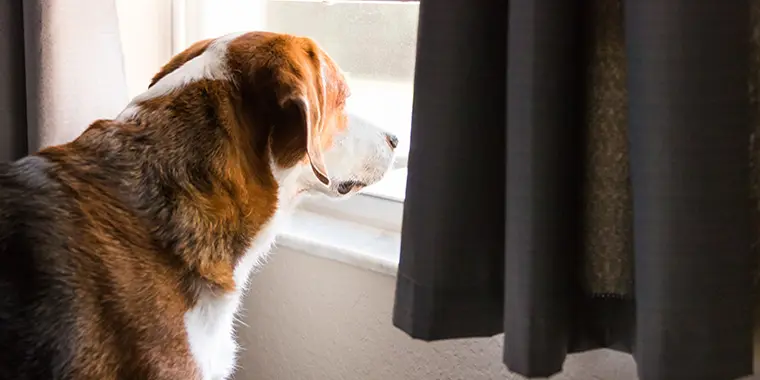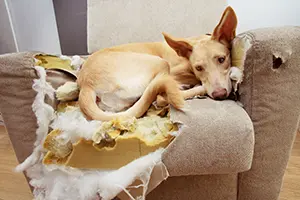
Every dog finds forced isolation unpleasant. No dog enjoys you going to work and leaving them alone for eight to ten hours a day. Dogs are social creatures. While dogs sleep a lot and do need their alone time, most of the time, they would rather be with you than away from you. Some dogs just handle this separation better than others. However, separation anxiety in dogs goes far beyond this basic reality.
Introduction to Separation Anxiety in Dogs
Separation anxiety is not about a dog loving and missing you too much. Instead, it is an unhealthy level of dependence. The problem is not the level of love but the nature (or structure) of said love. Separation anxiety in dogs is comparable to a jealous relationship partner who is consistently checking up on you. A jealous partner doesn’t love you more than someone who trusts you. They can’t handle their emotions well, and as a result, the relationship is disordered in a fundamental way.
This instability is driven by uncertainty. The trust that the person will return is missing. The dog is concerned about never seeing you again each time you leave the home. This connects with The Layered Stress Model on the clarity layer. Clarity about any situation is essential to dogs; therefore, we often refer to dogs needing to understand the picture. Some dogs and people need more clarity than others. The more clarity there is, the lower the stress level for the dog.
Line-of-Sight Separation Anxiety in Dogs
This is a lack of confidence in making choices in front of the owner. The dog is usually fine to be by himself. However, it can’t be calm when separated from the owner but within sight.
These are often trainer’s dogs that have been over-trained. They are afraid to make decisions independently when the owner is present. Because they fear harsh consequences for making mistakes. As a result, they always want to be told what to do.
We want to avoid that. The more confident a dog is in making decisions in front of its owner, the more confident it will be in making decisions in general.
Restructuring the Relationship with Your Dog
Addressing separation anxiety in dogs requires restructuring your relationship with your canine partner. Dogs do best when our relationship with them is clear, predictable, and consistent. The better a dog understands the relationship, the healthier the relationship will be. Dogs crave clarity and understanding. To predict the outcome of their choices, they need to have a reasonable expectation of how those around them will behave. Not being consistent in how we present material, ideas, or what we want creates a lot of stress in dogs, as they can no longer predict the outcomes of their behavior.
Clarity Matters for Separation Anxiety in Dogs
Inconsistency and a lack of clarity also create a sense of desperation. Why should a dog try to do the “right thing” when there is no “right thing?” If the “right thing” keeps changing and they have no way of knowing or meeting the expectation, they might as well do what they feel like doing and deal with the consequences. Such uncertainty creates a lot of anxiety, as your dog doesn’t understand where he fits and where you fit. If you want to call creating a clear structure leadership, go for it. But understand that creating clarity helps your dog, not being the boss.
Because it is necessary to create more structure and predictability for your dog to help it, it is easy to misinterpret the training approach as establishing dominance. However, creating structure isn’t related to dominance. Creating structure is related to clarity. And as many people still believe pack structure is the key to canine happiness, the subtle but important difference between structure for clarity vs. structure for pack order is overlooked.
Two Models of Dog Ownership
Having said this, addressing separation anxiety in dogs through creating clarity fits with both models of dog ownership, the pack-oriented model and the partnership model. It works the same, regardless of whether the true reason for it working is understood or not. Assuming the system is functioning, the light will come on if you flip the switch, regardless of one understanding of how electricity works. However, understanding the “how” will matter if the light doesn’t come on.
The training goal is not for your dog to care less about you but to change the structure of your relationship, so everything makes more sense to your dog.
Separation Anxiety in Dogs is Unique to the Dog
Every dog is different. As a result, everything recommended in this article has to be customized to your dog. These are general approaches to dealing with separation anxiety in dogs. Some dogs will improve just by doing one or two things. Others may need more of them. Some should be permanent lifestyle changes, others temporary adjustments. These are suggestions you can try to help your dog become better. If you can’t progress in a few months, hire a professional dog trainer for virtual guidance or in-person sessions. Separation anxiety in dogs is best addressed in the home. Board and training programs can help, but some work will still have to be done at the home.
Ways to Improve the Relationship with Your Dog
01. Train Your Dog
Establishing a training relationship with your dog will make a big difference. However, not all training is created equal. The training should focus on living with your dog and not just specific niche areas. It needs to be deliberate training, not just making the dog sit whenever you see it.
The dog needs to learn how it relates to the world and how the world relates to it. Your friend must learn how it fits into our social structure. What is optional, and what is mandatory? What is negotiable, and what isn’t? For the dog to be able to predict the outcome of its choices, it needs to have a reasonable expectation of the behaviors of other people and animals around it. Separation anxiety in dogs can be reduced through training. However, it is rarely sufficient.
The Correct Training Focus
You want the training to build ideas about how the world works, not just what to do when you say “sit.” You want to build good habits and help your dog learn to make good choices. For example, the dog must learn the following:
- To be comfortable with being bored.
- That couch time is not an invitation to jump all over people.
- To be calm on the leash.
- To keep 10% of his attention on you outside the home.
- And so on.
Most of these things can be easily accomplished using leashes and crates strategically throughout the day. The training should build a system where the dog knows what is expected and general attitudes. We accomplish that by creating barriers and conduits for the dog to access things he likes. The goal is to create a dog that is pleasant to live with.
02. Create a Consistent Daily Schedule
Consistency and predictability have a very calming effect and can help with separation anxiety in dogs. Examples:
- Feed at the same times every day; twice a day during this process.
- Offer potty breaks regularly.
- Take your dog for walks daily, around the same time, ideally in the morning and evening; even 10 minutes before work helps (rain or shine).
- Feed your dog after the walk.
- And so on.
Every person in the home must follow the same, consistent routine, so your dog can predict the outcome of its behaviors.
03. Tethering, aka Umbilical-Cord-Training
Have your dog on a leash attached to your belt, or purchase something like The Buddy System and go about your business as usual. Your dog must follow you wherever you go. Counter to what you may have thought, this helps reduce separation anxiety in dogs.
This allows you to stop behaviors you don’t want and encourage behaviors you do want by creating rules and boundaries. This also uses the principle of futility. Whenever the dog gets undesirable ideas, it is stopped in its tracks and learns that thing it just tried didn’t work. It’s a great way to get a dog to give up on behaviors and kill motivation for the wrong things. Futility is a great motivator against things.
Even if your dog already follows you around most of the time, still do this. It is a different experience between choosing to do something and not having another option.
04. Deference Training aka Nothing in Life is Free (NILIF)
This teaches the dog that you are a conduit to good things, and it teaches it to be polite. But it also creates a subordinate relationship. Because of this last point, I generally don’t subscribe to the NILIF approach with dogs for regular training and everyday living. But to help with separation anxiety in dogs, this is a good training approach to employ for a few months. Also, with some dogs, this may be a lifetime adjustment to keep their separation anxiety in check, especially if their insecurity is mostly genetic.
Step 1: Sit before I Pet You
- When the dog jumps up, your raise your hands like you’re being mugged.
- Take a straight step back.
-
Once the dog’s front paws touch the ground again, give the ‘sit’ command:
- If he sits, pet him.
- Should he jump up again, repeat the process from 1.
- If he walks away, do nothing.
- When he comes back later, repeat the process from 1.
- If he jumps up the moment you touch him, stop and repeat the process from 1.
Once you pet him, he can stand up on all four legs, but if he jumps up, repeat the process from 1.
Step 2: Establish a Food Schedule
- End all free feeding.
- Offer two scheduled feedings a day.
- Food is only offered for 10 minutes; then, the food is removed.
Step 3: Sit before I Feed You
- Prepare the food on the counter.
- Pick a random number between 5 and 10.
- Pick up the food bowl, turn towards the dog and say his name followed by the sit command (e.g., Max, sit).
- In your head, count to that number.
- Begin to put the foot down. If the dog jumps up, repeat the process from 2. with a new number.
The dog must wait until the bowl is on the ground and you say “okay” (or whatever release word you have) before it gets to eat. Should you realize, this will not work because the dog is too excited, put the food away and try it again during the next scheduled feeding. Don’t repeat this more than 15 times in one feeding attempt.
Also, don’t try it again an hour later; wait until the next feeding. The dog needs to know that if it decides not to eat, it’s deciding not to eat for 8 hours or so. When the dog understands the consequences of his decisions are more consequential, it takes the decision more seriously.
This is not about control. It is about motivation. What is the cost of this decision?
05. Crate Training
Teaching a dog to be calm in the crate is very important to help address separation anxiety in dogs.
-
In case of multiple people in the household, the crate needs to be in the room of the person that goes to bed last most nights.
One of the problems many people have with crate training is that they isolate the dog physically and socially in the laundry room or basement. A place where the dog is left alone with no human activity. This can cause a significant amount of stress in a dog and, depending on its psychological makeup, help create separation anxiety in dogs.
- The bedroom is important because it smells more like us than any other room in the home.
-
The last thing you do before you turn off the lights is, put the dog in the crate and close the door. Turn off the lights, get in bed, and sleep.
The dog is with you, and everybody else is already asleep, so there is no fear of missing out, and it helps create a conditioned relaxation response to the crate. The crate becomes the place where your dog sleeps. It becomes a place to relax and be calm and comfortable. This will work with most dogs.
06. Crates, Kennels, Dog Runs, and Boarding

The only reason for crating your dog when you’re gone is to prevent it from getting into trouble, hurting itself, destroying property, or getting loose. Aside from those concerns, consider not crating your dog.
Some dogs do much better in a closed room than in a crate; this is worth testing. Leave your home for 5 to 10 minutes and monitor your dog’s reaction using your phone, a baby monitor, or a wireless security camera.
A dog run can also be a great alternative to a crate. It could be in your basement or your backyard.
Board-and-train programs can be great for addressing separation anxiety in dogs because it creates a necessary separation, and separation anxiety is not just about being alone. It’s about being separated from a specific person. However, at the end of the stay, the dog still needs to be acclimated to the crate in your home.
Ways to Build Good Crate Associations:
- If your dog already has bad crate associations, consider using a different type of crate to start over. If your dog hates wire crates, use a transport crate.
- Feed your dog in its crate.
- Use crate time as a pseudo ‘place’ command during training sessions (with the door open).
- Make the ‘kennel’ command part of playing tug. Sequence: out — kennel — down — wait — yes → play again. Get your dog to the point where it can be left in the crate for 5 to 10 minutes with a closed door. However, during the initial stages of this game, take the door off (or secure it to stay open) so the door doesn’t shut by accident. Also, have his bedding in the crate.
-
Marc Goldberg’s Straw Method
Marc Goldberg is a well-known veteran pet dog trainer in Chicago. He has described his straw method for crate and potty training on several public podcasts and posted it online. You can read the full written description here: Separation Anxiety in Dogs: The Cure is Straw, and watch the YouTube explanation here: The Straw Method; please check them out. I will provide a quick outline of the approach below. If you want to read all details, please buy Marc’s book Let Dogs be Dogs. It contains this jewel and many other great tips for common dog challenges.
- The straw method works because it speaks to the dog’s nesting instinct. Having things rolled up to the body of the puppy creates comfort.
- Use a transport crate.
- Start by filling the crate with straw up to the leg height of the dog.
- Foraging in the crate is better than anxiety. Throw some treats in for the puppy to search for in the straw.
- Straw doesn’t absorb liquids, so urine will not soil the straw immediately. But change the straw at least weekly. Put potty pads under the straw and change those out as needed. If you place a stack of potty pads under the straw, you only have to pull one out once it gets dirty. Put a sheet under the crate to catch additional spills and straw.
- Give it a couple of weeks, and then remove a handful of straw daily.
-
Addressing separation anxiety in dogs can be tricky.
Ideally, your dog gets comfortable in the crate and doesn’t mind. However, sometimes we have dogs that destroy the home and need to be created immediately but will also hurt themselves trying to break out of their crates in your absence. In such a case, use crates your dog can’t hurt themselves in or break out of. I use Impact Dog Crates in those cases. They are not cheap, but better and cheaper than an injured dog or a destroyed home. For tougher cases, Gunner Kennels or Zinger Dog Crates may be necessary.
07. Adjustment Time
If you crate the dog, make that the last thing you do before you leave to help address separation anxiety in dogs.
- Give the dog time to adjust when you’re leaving. Have consistent rituals. Clarity helps. After you’ve done everything, you’re doing anyway, like putting your coat on, grabbing your keys, tying your shoes, and so on. Sit down for 5 minutes and give your dog time to adjust to the fact that you are leaving.
-
When leaving outside your regular schedule—for example, on the weekends—spend some quality time with your dog an hour before you leave. Examples:
- Play tug or fetch
- Scent work
- Have fun
- Other biologically fulfilling activities
Do that for as long as it takes for your dog to be satisfied. Also, give it a chance to calm down before leaving. The goal is to get the dog mentally tired and fulfilled.
08. Activate Seeking (Create Novelty)
- Consider giving your dog a frozen, stuffed Kong toy. Use peanut butter, honest kitchen, or a canned dog food mix as filler. This can keep it occupied when you’re leaving. The first 5-15 minutes after leaving are the most critical. Giving the dog something to focus on during this initial period can be very beneficial.
-
Make a treasure box.
- Get a cardboard box, tape, newspaper, and chew toys like antlers, bully sticks, and treats.
- Crumple up the newspaper and make balls. Hide treats in some of them.
- Mix the paper balls with a variety of chew toys. Mix different ones, not just multiple of the same type. Ideally, several with different textures, but all safe for your dog to have on its own.
- Tape the box shut. Don’t make it Ford Knox. Just tape it well enough, so the dog must work a bit to open it. You can punch a couple of holes in the top so the dog can pick up on the scent even better.
- You should be able to reuse the box several days in a row.
The treasure box and the Kong toy keep the seeking system active before leaving, so you want to give those to the dog right before you head out.
09. Controlling the Emotional State
When you leave, you want your dog to be emotionally neutral. Don’t try to get the dog happy or excited before you head out. If you are creating a tremendous amount of excitement, you are creating the expectation that you will do something fun. If you instead head out, you leave your dog in the worst possible state of mind. It will be extremely frustrating as your dog expected to do something fun and not be left home alone in the crate.

You also want to return your dog to an emotionally neutral state when you return home. If you get your dog all excited when you come home, you are creating a huge difference in the state of mind between being away and coming home. That can create frustration, as this stimulation is unavailable during your absence. Let your dog calm down first. Only once it settles, turn your attention towards your dog and pet it or play with it.
Our instinct is wanting to reward the dog for being good. And that’s fine, but excitement is not our friend. Excitement and fear are very close to each other biochemically. For example, the heart rate increases, the blood pressure increases, the pupils dilate, the blood vessels dilate, tunnel vision forms, etc.
Separation Frustration
Separation anxiety in dogs may be misnamed. It’s the rage system that causes the destructive behavior, and that’s triggered by frustration. So maybe separation frustration would be a better name. The dog becomes frustrated by not being able to change its situation. This may be why obedience training is helpful with separation anxiety. Because during obedience training, the dog learns how to handle frustration better. During obedience, we’re putting the dog in harder and harder situations and helping it work through them. This helps build the ability to handle frustration.
Being able to handle frustration also builds confidence. Frustration comes from the inability to succeed. It doesn’t come from not overcoming obstacles. It comes from thinking of not being able to overcome obstacles.
10. Anxiety Medication
We are medicating dogs in an alarming manner that parallels the use of drugs in human psychiatry. Yet, there are few studies on these medications’ long-term use, which should give us pause.
Such drugs come with side effects and major health and welfare warnings regarding how the drugs affect the workings of the heart, the liver, the kidneys, and the brain.
What is the Scientific Evidence for Drugs?
“Selective publication of clinical trials on psychotropic drugs also could lead to a bias about their perceived effectiveness,” according to a study led by researchers at the Portland Veterans Affairs Medical Center (New England Journal of Medicine, 2008).
The study “Effectiveness of Antidepressant: An Evidence Myth Constructed from a Thousand Randomized Trials?” published in The New England Journal of Medicine in 2008, examined 74 FDA-registered studies for a dozen antidepressants and found that most studies with negative results were not published in the scientific literature or were published in a way that conveyed a positive outcome. This finding raises the question of what evidence we truly have for the efficacy of antidepressant drugs.
What does this mean? Be wary of anxiety medication for dogs!
Given this, I am not a fan of anxiety medication for dogs, but here are some natural remedies worth knowing about.
Natural Remedies
Calmer Calm was only supposed to be used for a maximum of 90 days as part of a training protocol. Now it’s being prescribed continuously instead of training. It was designed to supplement training, not substitute training. Most trainers feel it does nothing. If you change the training, you don’t know if the drug helps; if you don’t change the training, the drug does nothing, as the literature predicts.
Rescue Remedy is a natural supplement many trainers like.
Comfort Zone is also called dog appeasing pheromone (dap); it either works great or not at all.
Plug-In Diffusers can help with stress barking. Stress barking is rhythmic; you can almost set a metronome after it. Don’t be stingy when using a diffuser. Plug it in all the time, not only when you’re leaving. Good essential oils to use with diffusers are lavender and Valerian root.
Cannabis Oil can work great. But when dealing with anxiety, CBD oil alone won’t accomplish much. You need some THC in the mix to have an effect. The cannabis company Care by Design makes tinctures in ratios 18:1, 8:1, 4:1, 2:1, and 1:1. You can buy these at any dispensary. I started at a 5:1 ratio with a 75 lb German Shepherd under the guidance of a cannabis-specialized veterinarian without any issues. I wasn’t dealing with anxiety in this case, but it was a safe starting point. If you want to change the ratio of THC/CBD, you need extra CBD oil. I use Earth Buddy Pet 1000mg for this purpose. Both products were recommended by the veterinarian and have worked great for me. If you are unsure how to get started, the experts from VeterinaryCannabis.org are a great resource.
Final Note on Drugs
If you end up trying a natural remedy for anxiety, please use them as part of a larger training plan and have the goal of not needing or relying upon it.
11. Interrupters
Using interrupters can be very helpful when addressing separation anxiety in dogs. Interrupt barking by standing outside the kennel room and making a sudden sound like dropping a book. The dog will stop to listen to what is happening and then continue barking. Drop it again. After five to six times, most dogs stop.
A variation of this can be created with a metal food bowl, some coins, and an e-collar (any collar will do as long as it can vibrate). Place the coins and the e-collar receiver in the food bowl and on top of the dog’s crate. Keep the remote with you. When the dog barks, hit the vibrate button. The rattling coins in the bowl will create a disruptive sound.
12. Bark Collars
Bark collars for addressing separation anxiety in dogs are a mixed bag of goods. The problem with bark collars is that they activate on ALL barking, not just nuisance barking. But, some barking must be allowed, particularly involuntary barking. When a dog is startled and barks in response, that is involuntary. The dog does not control that. If such barking is corrected, we can worsen the problem as the dog becomes unstable. A bark collar that allows for this is the Garmin Bark Delimiter 2.
A Few Points on Using Bark Collars.
- Don’t use citronella spray collars. The correction lasts long past the event, which is a bad idea.
- Use a bark collar activated by vibration, not sound, so it isn’t set off by ambient sounds or other dogs barking.
- Use a bark collar that allows for some barking (ideally a programmable number of barks) before activating.
- Bark collars use an aversive as an interrupter. Ensure the stimulation or vibration happens after the bark and not at the same time. This is related to the laws of classic conditioning. How the stimulation works depends entirely on the brand you are using. In the past, I used the Garmin Bark Delimiter 2. It does it correctly.
- Dogs can work themselves into a crisis through repetitive barking. A bark collar can interrupt this process early on. We want to stop the loading process. A bark collar is one way of doing that. It solves the dog’s problem by keeping the stress level low. However, if the loading behavior isn’t barking, a bark collar won’t help.
- Instead of a bark collar, a regular e-collar and a baby monitor allow for disrupting loading behavior manually.
The biggest problem with bark collars is that they can misfire. I stopped using bark collars for this reason, and if I try this approach with a dog, I now do it manually with a regular e-collar.
Meet Your Dog’s Genetic Needs First
Trainers’ opinions on using e-collars or bark collars for barking in the crate will vary. I start by creating a biologically fulfilling lifestyle for the dog to meet its genetic needs first. This alone may stop the problem. If the barking persists, it most likely has become a habit that needs to be broken. At that stage, using a manual e-collar as an aversive is the fastest and most humane way to address the problem, as the underlying root cause no longer exists. There is no kindness in letting a dog get unnecessarily stressed over and over when one proverbial slap on the wrist will end the suffering.
13. Create a Home Separation Routine
Get your dog used to separation by creating an in-home routine of not interacting with your dog for a few minutes at a time. You can decide on a signal so the entire family knows when it is in progress. E.g., an uncommon book is placed on the dinner table.
Once the routine starts, place the book on the table, and no family member interacts with the dog for 5 minutes. Ignore him. After 5 minutes, place the book back to where it came from and interact with your dog as usual.
Repeat this routine 1-2 times a day and gradually increase the time in increments of 5 minutes.
Once this starts working well for up to 15 minutes, it’s time to add some distance and isolation to this routine. Use leashes, back ties, crates, and so on to get your dog comfortable with more and more “self-time.”
Through this process, your dog learns that sometimes it has to entertain itself.
Conclusion to Separation Anxiety in Dogs
I hope these suggestions help you control your dog’s separation anxiety. These successful strategies have worked on many dogs in the past. If you still need more help, please hire a professional dog trainer. They may want to try one of these approaches again. Even if it didn’t work when you tried it, let them. It matters a lot how exactly these approaches are executed. A professional will have more experience than you.
None of these are supposed to be permanent lifestyle changes. These are deliberate changes in the structure of your relationship to teaching your dog to see you differently. It allows you to reshape behaviors you don’t like and build confidence in your dog regarding your relationship. Again, this is not about control. It is about teaching your dog how to get along in society.
The information in this article is largely based on two podcast episodes of Something to Bark About by Chad Mackin. Please check them out and consider subscribing. It is one of my regular dog podcasts to listen to. Separation Anxiety in Dogs: Episode 1 | Episode 2.
Play the Audio





